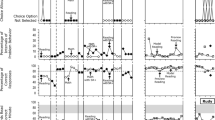Abstract
Effects of two types of cognitive modeling (problem-solving rules vs. coping self-instructions)on laboratory test anxiety were examined in two experiments. Both studies included assessment of observers' cognitive processes while working anagrams to evaluate modeling effects on cognitive tactics and to determine how they related to subsequent behavior. Experiment 1 investigated the influence of type of modeling and model reward on performance. Experiment 2 served to replicate any modeling effects and used a pre-post assessment of observers' strategies to clarify how modeling operated. Results from both studies offered some support for the multiple influence of cognitive modeling procedures over a model control, but were equivocal regarding the relative superiority of the two types in facilitating anagram performance. Modeling effects were limited by unequal difficulty among anagrams and perceived differences in relevance of particular tactics providing mixed support of Sarason's research. Assessment of observers' cognitive processes suggested that negative self-talk was task interfering and imitation of solution rules but not coping instructions was associated with quicker solution. Pre-post analysis revealed that college female observers possessed a repertoire of solution rules similar to modeled rules and that modeling acted to increase subsequent use of tactics in contrast to controls.
Similar content being viewed by others
References
Bruch, M. A. Coping model treatments: Unresolved issues and needed research.Behavior Therapy 1976,7 711–713.
Crager, R. L. The relation of anxiety, sex, and instructions to performance and verbal behavior during anagram solution. Unpublished doctoral dissertation, University of Washington, 1959.
Kazdin, A. E. Covert modeling and the reduction of avoidance behavior.Journal of Abnormal Psychology 1973,31 87–95.
Kazdin, A. E. Effects of covert modeling and reinforcement on assertive behavior.Journal of Abnormal Psychology 1974,83 240–252.
Kunce, J. T., Bruch, M. A., & Thelen, M. H. Vicarious induction of academic achievement behavior in disadvantaged adults.Journal of Counseling Psychology 1974,21 507–510.
Meichenbaum, D. Examination of model characteristics in reducing avoidance behavior.Journal of Personality and Social Psychology 1971,17 298–307.
Meichenbaum, D. Cognitive modification of test anxious college students.Journal of Consulting and Clinical Psychology 1972,39 370–380.
Meichenbaum, D., & Goodman, J. Training impulsive children to talk to themselves: A means of developing self-control.Journal of Abnormal Psychology 1971,77 115–126.
Russell, D. G., & Sarason, I. G. Test anxiety, sex and experimental conditions in relation to anagram solution.Journal of Personality and Social Psychology 1965,1 493–496.
Richardson, F. C.A self-study manual for students on coping with test-taking anxiety. Unpublished manual, University of Texas at Austin, 1973.
Sarason, I. G. Experimental approaches to test anxiety: Attention and the uses of information. In C. D. Spielberger (Ed.),Anxiety: Current trends in theory and research (Vol. 2). New York: Academic Press, 1972. (a)
Sarason, I. G. Test anxiety and the model who fails.Journal of Personality and Social Psychology. 1972,22 410–413. (b)
Sarason, I. G. Test anxiety and cognitive modeling.Journal of Personality and Social Psychology 1973,28 58–61. (a)
Sarason, I. G. Test anxiety and social influence.Journal of Personality 1973,41 261–271. (b)
Sarason, I. G. Anxiety and self-preoccupation. In I. G. Sarason & C. D. Spielberger (Eds.),Stress and anxiety (Vol. 2). New York: Wiley, 1975. (a)
Sarason, I. G. Test anxiety and the self-disclosing coping model.Journal of Consulting and Clinical Psychology 1975,43 148–153. (b)
Wine, J. Test anxiety and direction of attention.Psychological Bulletin 1971,76 92–104.
Winer, B. J.Statistical principles in experimental designs. New York: McGraw-Hill, 1971.
Author information
Authors and Affiliations
Additional information
This research was sponsored in part by a small grant from the Bradley Board of Research, Creative Production, and Sponsored Programs, Bradley University.
Rights and permissions
About this article
Cite this article
Bruch, M.A. Type of cognitive modeling, imitation of modeled tactics, and modification of test anxiety. Cogn Ther Res 2, 147–164 (1978). https://doi.org/10.1007/BF01172728
Issue Date:
DOI: https://doi.org/10.1007/BF01172728




